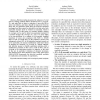Free Online Productivity Tools
i2Speak
i2Symbol
i2OCR
iTex2Img
iWeb2Print
iWeb2Shot
i2Type
iPdf2Split
iPdf2Merge
i2Bopomofo
i2Arabic
i2Style
i2Image
i2PDF
iLatex2Rtf
Sci2ools
ICST
2010
IEEE
2010
IEEE
(Un-)Covering Equivalent Mutants
—Mutation testing measures the adequacy of a test suite by seeding artificial defects (mutations) into a program. If a test suite fails to detect a mutation, it may also fail to detect real defects—and hence should be improved. However, there also are mutations which keep the program semantics unchanged and thus cannot be detected by any test suite. Such equivalent mutants must be weeded out manually, which is a tedious task. In this paper, we examine whether changes in coverage can be used to detect non-equivalent mutants: If a mutant changes the coverage of a run, it is more likely to be non-equivalent. In a sample of 140 manually classified mutations of seven Java programs with 5,000 to 100,000 lines of code, we found that: (a) the problem is serious and widespread—about 45% of all undetected mutants turned out to be equivalent; (b) manual classification takes time—about 15 minutes per mutation; (c) coverage is a simple, efficient, and effective means to identify equival...
ICST 2010 | Mutants | Mutation | Software Engineering | Test Suite |
| Added | 26 Jan 2011 |
| Updated | 26 Jan 2011 |
| Type | Journal |
| Year | 2010 |
| Where | ICST |
| Authors | David Schuler, Andreas Zeller |
Comments (0)

